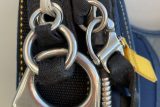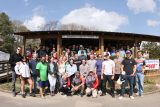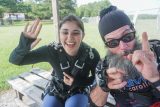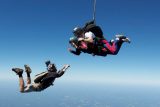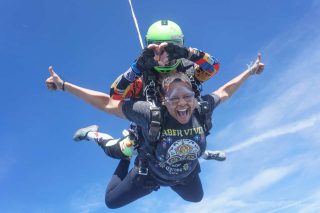7 Questions Everyone Should Ask Before Booking a Tandem Skydive
FAQ
10 years ago
What to Know before You Book
This year, Skydive Carolina is proudly celebrating its 29th year of serving the Columbia, Greenville, Spartanburg, Charlotte, and Central Piedmont areas! Over the years we’ve learned that when our guests finally decide they are ready to take the leap, many are not sure how to evaluate the services offered by the different skydiving centers in their area. We understand that deciding to jump out of a plane is a BIG deal. We also understand that when you book your skydive you want to be 100% sure that you’ve chosen the safest, most trust worthy skydiving center possible. Here are a few important questions you should ask when deciding where to make your tandem skydive:
1. What Altitude Do You Jump from?
One of the first questions a licensed skydiver will want to know before visiting a drop zone is what kind of aircraft they fly. Why? One word: altitude. The higher the jump altitude, the more time spent in freefall. More time spent in freefall = more fun and more value for your dollar! So if you’re making your first tandem skydive, altitude is definitely a factor you should take into consideration when deciding where to jump.
The majority of skydive centers in the Carolinas fly a Cessna 182 aircraft, which is a great plane, but it usually only flies to a max altitude of 10,000 feet. Cessna 182 skydive centers (it’s how we started 29 years ago) have always been the backbone of the skydiving industry, but turbine aircraft drop zones enhance the jump experience by offering higher altitudes (usually to 13,500 to 14,000 feet) with more comfort due to a more spacious cabin. Presently, Skydive Carolina flies a Beechcraft King Air rocketing jumpers to 13,500 feet in a super fast eight minutes and a Grand Caravan taking jumpers to 13,500 feet in 15 minutes.
Savvy shoppers will want to make price comparisons based on the altitudes being offered as many smaller drop zones offer similar pricing at lower altitudes.
2. What Type of Video Services Do You Offer?
Nearly every skydiving center offers video services for the jump, but be aware of the difference between outside video and handcam video. Many smaller skydiving operations offer handcam video which is essentially a GoPro attached to the instructor’s arm. It is awesome for capturing the experience, but because of the close frame of the shot, it can’t capture the different outside angles an independent videographer flying with you in freefall could. An outside videographer is better able to document your thrilling exit and every spine-tingling moment of your freefall.
Many operations who offer handcam swear it’s better, but if given the choice, the majority of first-time jumpers would take outside video over handcam nearly every time.
3. Can Everyone in My Group Jump Together?
If you’ve been given the responsibility of organizing a group to go skydiving, you’ll want to carefully pick your skydiving center and take the factor of time into consideration. Once again, Cessna 182 drop zones can usually only accommodate 4-5 jumpers (two tandem pairs) at a time. Between training, gearing up, a 20 minute flight to altitude and then de-gearing students and gearing up new ones, it can take several hours for small groups to complete their jumps. Group leaders with three or more people should consider larger operations to keep things moving. It’s not much fun landing and feeling an incredible ‘high’ only to wait several hours for the rest your party to complete their jump.
4. What’s the Best Time of Day to Jump?
The best time of day to skydive is in the morning… the earlier the better. Because weather plays a big role in skydiving, delays can occur. Early morning booking times offer several advantages:
- Better weather. Usually morning conditions are more benign (especially during the summer months), so the risk of weather delays decrease the earlier you book.
- Shorter Wait Times. If there’s a delay and you’re one of the first groups to arrive, then you’ll be the first to gear up and jump once the delay is over! If you arrive later in the day and 20 people are ahead of you due to weather delays, be prepared to wait!
- Cooler Temps. We all know what Carolina summers are like – it gets hot! Arrive in the morning, make your jump during cooler weather, and then enjoy your day with a permanent smile fixed on your face! ??
5. Is this a REAL Skydiving Center?!?
Sad to say, but buyer beware! There are several third party companies that create false websites for skydiving centers that do not exist! You call to make a reservation and are routed to a call center where the representative will charge an exorbitant amount for a skydive and then redirect you to an actual skydive center receiving their vouchers… usually not anywhere near your town.
Here’s what you should watch for:
- An address. Look carefully for a physical address. These nondescript skydiving websites will have a geographic name, but not a physical address. If they do have an address (some have realized it was a red flag) take it another step further:
- Plug the address into Google Maps. Make sure the address is actually located at an airport. If they’re not at an airport, they are not a skydiving center.
- Call them before booking online. Trust your gut. If they seem disinterested and borderline rude, you may not want to be jumping with them anyway!
6. Are You a USPA Member?
No skydiving center is mandated to join the nationally recognized governing body of skydiving – the United States Parachute Association (USPA). The USPA is a member driven association that sets guidelines for safe practices in the sport and represents the skydiving industry to government agencies. USPA Member drop zones are expected to adhere to the guidelines set forth by the USPA. It’s usually a red flag if skydiving centers are not members. Click here to see the list of USPA member drop zones and make sure the skydive center you select is on this list.
In Summary
In summary, these are the questions you should be asking when calling a facility:
- What kind of aircraft do you fly and what is the capacity?
- What altitude do you jump from? Do you have to pay more for higher altitude?
- If bringing a group, approximately how many in a party can go up at a time?
- Do you offer outside video or handcam video?
- What’s the earliest time slot you offer and do you offer an Early Bird jump discount?
- What is the physical address of your skydive center?
- Are you a USPA member drop zone?
